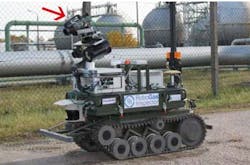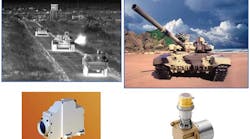FLIR robotic system performs optical gas imaging
Sensor company FLIR Systems (Meer, Belgium) has developed a new robotic system for remote detection and localization of gas leaks in large industrial facilities. Developed as part of the German technology program AUTONOMIK, a consortium of nine companies and research institutes, FLIR says the RoboGasInspector provides a safer, more efficient, and more reliable detection solution for gas leaks in industrial facilities.
Related Article
Operators of industrial facilities including chemical plants, refineries and gas compression stations place great importance on the safety of their staff and their production facilities. Exercising the utmost care wherever toxic or explosive gases are used or manufactured is absolutely essential. Traditionally this has required preventive inspection programs where personnel perform time consuming routine inspection procedures on a daily basis.
Incorporating a FLIR GF320 optical gas imaging camera, the RoboGasInspector is able to perform inspection tasks in industrial facilities without having to access hazardous areas directly—and without requiring any human presence. The robotic system can be used for routine inspection of facilities or for targeted inspection of specific parts of plants. The independent mobility of the system was achieved using various navigation sensors, while maintaining the option of manual intervention via remote control at any time. The RoboGasInspector is also equipped with video and optical gas telemetry, which enables it to inspect system parts that were previously difficult to inspect due to restricted accessibility.
The RoboGasInspector consists of three modules: a chain-driven mobile platform, a navigation module, and an inspection module. The chain-driven platform is equipped with an electric drive and conventional batteries. The inspection module combines various metrological instruments on a pan-tilt unit, including a Remote Methane Leak Detector and a FLIR GF320 thermal imaging camera to visualize the gases. To ensure that the RoboGasInspector does not itself pose a risk, it is also equipped with a built-in gas sensor that shuts down the entire system from 10% of the lower explosion limit (LEL) onwards in order to prevent possible danger to a flammable atmosphere.
FLIR says optical imaging with thermal imaging cameras such as the FLIR GF320 offers numerous advantages, as larger areas can be covered significantly faster than with conventional methods and detection also succeeds in sectors that are difficult to access with contact measuring devices. Leaks are shown as plumes of smoke in the thermal image.
FLIR Systems says it designs, manufactures, and markets sensor systems that enhance perception and awareness. Its thermal imaging and threat detection systems are used for a wide variety of imaging, thermography, and security applications, including airborne and ground-based surveillance, condition monitoring, research and development, manufacturing process control, search and rescue, drug interdiction, navigation, transportation safety, border and maritime patrol, environmental monitoring, and chemical, biological, radiological, nuclear, and explosives (CBRNE) detection.
SOURCE: FLIR; http://www.flir.eu/ogi/display/?id=62559
About the Author

Gail Overton
Senior Editor (2004-2020)
Gail has more than 30 years of engineering, marketing, product management, and editorial experience in the photonics and optical communications industry. Before joining the staff at Laser Focus World in 2004, she held many product management and product marketing roles in the fiber-optics industry, most notably at Hughes (El Segundo, CA), GTE Labs (Waltham, MA), Corning (Corning, NY), Photon Kinetics (Beaverton, OR), and Newport Corporation (Irvine, CA). During her marketing career, Gail published articles in WDM Solutions and Sensors magazine and traveled internationally to conduct product and sales training. Gail received her BS degree in physics, with an emphasis in optics, from San Diego State University in San Diego, CA in May 1986.

